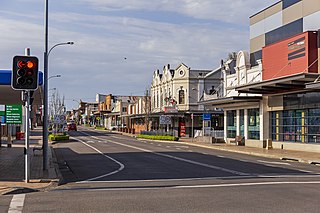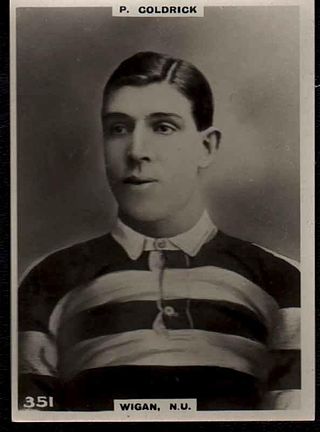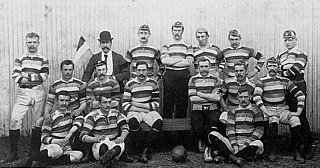
Cessnock is a city in the Hunter Valley of New South Wales, Australia, about 52 km (32 mi) by road west of Newcastle. It is the administrative centre of the City of Cessnock LGA and was named after an 1826 grant of land called Cessnock Estate, which was owned by John Campbell. The local area was once known as "The Coalfields", and it is the gateway city to the vineyards of the Hunter Valley, which includes Pokolbin, Mount View, Lovedale, Broke, Rothbury, and Branxton.

Andrew Ernest Stoddart was an English sportsman who played international cricket for England, and rugby union for England and the British Isles. He was a Wisden Cricketer of the Year in 1893.
Thomas Patrick David is a Welsh former dual-code international rugby union and rugby league footballer who played in the 1970s and 1980s. He was born in Pontypridd, and played representative rugby union (RU) for Wales and the British Lions and rugby league (RL) for Wales. He was selected for the 1974 British Lions tour to South Africa, and at the time played club rugby for Llanelli RFC. He also played for his home-town club Pontypridd RFC, and while at the club was part of the 1976 Grand Slam winning Wales team. In 1981 he switched codes to rugby league, representing Cardiff City Blue Dragons.
Broughton Rangers were one of the twenty-one rugby clubs which met at the George Hotel, Huddersfield, in 1895 to form the Northern Rugby Football Union. They were originally based in Broughton, Salford, but in 1933 moved to Gorton, Manchester to play at the Belle Vue Stadium, and were renamed Belle Vue Rangers in 1946. The club folded in 1955.

The 1888–89 New Zealand Native football team was a New Zealand rugby union team that toured Britain, Ireland, Australia and New Zealand in 1888 and 1889. It mostly comprised players of Māori ancestry, but also included some Pākehā. A wholly private endeavour, the tour was not under the auspices of any official rugby authority; it was organised by New Zealand international player Joseph Warbrick, promoted by public servant Thomas Eyton, and managed by James Scott, a publican. The Natives were the first New Zealand team to perform a haka, and also the first to wear all black. They played 107 rugby matches during the tour, as well as a small number of Victorian Rules football matches in Australia. Having made a significant impact on the development of New Zealand rugby, the Natives were inducted into the World Rugby Hall of Fame in 2008.

Maitland High School is a government-funded co-educational comprehensive secondary day school, located on High Street, East Maitland, New South Wales, Australia.

Albert Percival "Percy" Coldrick was a Welsh dual code rugby player who played rugby union for Newport and rugby league for Wigan. He represented Wales under the union code and Wales and Great Britain under league rules.

The 1888 British Isles tour to New Zealand and Australia was a tour by a British rugby union team, known at the time as the "English Footballers", throughout New Zealand and Australia. Although a private venture not organised by any official body, this was the first major tour of the Southern Hemisphere undertaken by a European rugby team. It paved the way for future tours by teams which are now known as British and Irish Lions.

Thomas Bertie "Bert" Jenkins was a Welsh rugby union, and professional rugby league footballer who played in the 1900s, 1910s and 1920s. He played club level rugby union (RU) for Troedyrhiw RFC and Mountain Ash RFC, and representative level rugby league (RL) for Great Britain, Wales and Lancashire, and at club level for Wigan, as a centre.

James Haywood Cumberbatch was an English professional rugby league footballer who played in the 1930s. He played at representative level for England, and at club level for Broughton Rangers and Newcastle, as a wing.

James Valentine, also known by the nickname of "Jim Val", was an English rugby union, and semi-professional Northern Union footballer who played in the 1880s, 1890s and 1900s. He played representative level rugby union (RU) for England and Lancashire, and at club level for Swinton, as a centre and club level rugby league (RL) for Swinton, as a forward. Prior to 2 June 1896, Swinton was a rugby union club.
Thomas Banks was an English rugby footballer who played in the 1880s and 1890s. He played at representative level for British Isles, and Lancashire, and at club level for Swinton, as a half-back, three-quarters, or forward.
Charles Mathers was an English rugby union footballer who played in the 1880s. He played at representative level for British Isles and Yorkshire, and at club level for Bramley, as a forward. Prior to Tuesday 2 June 1896, Bramley were a rugby union club.

Harry Eagles was an English rugby union footballer who played in the 1880s and 1890s. He played at representative level for British Isles, and Lancashire, and at club level for Crescent FC, and Salford, in the forwards.

The Electoral district of County of Durham was an electorate of the New South Wales Legislative Council at a time when some of its members were elected and the balance were appointed by the Governor. It was named after Durham County, which lies on the north side of the Hunter River.
The 1848 New South Wales colonial election was held between 29 July and 2 August. No candidates were nominated for Port Phillip as a result of the campaign for independence from New South Wales, and a fresh writ was issued for an election on 3 October.
The 1851 New South Wales colonial election, was held between 12 and 25 September. It involved a re-distribution of electorates as a result of the separation of Victoria, which had 6 seats in the previous council, and the expansion of the council from 24 elected members to 36 elected members representing 31 electorates. The major changes were the addition of 8 pastoral districts and the separate representation for the northern regions of what would later become Queensland. These had previously been a part of the single district of Gloucester, Macquarie, and Stanley and from 1851 were covered by the separate districts of Stanley, Stanley Boroughs and the pastoral districts of Moreton, Wide Bay, Burnett, and Maranoa. The other 8 additional seats were distributed among the nineteen counties of New South Wales.
The 1888 Southern Rugby Football Union season was the 15th season of the Sydney Rugby Premiership. This was the sixth competition for the Gardiner Challenge Cup which was awarded to the winners of the premiership. The football season was from June till August 1888. The season culminated in the premiership, which was won by Sydney University who were crowned premiers who finished undefeated for the second year in a row. It was during 1888 that the first British Rugby team toured Australia and New Zealand playing two games against a NSW team. The intercolonial matches saw Queensland travel to Sydney to play two games against the home team.











